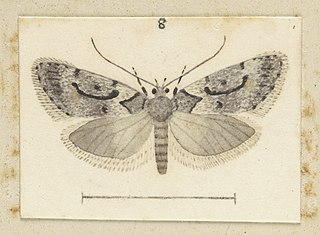
Izatha manubriata is a moth of the family Oecophoridae. It is endemic to New Zealand, where it is known from the southern South Island only.

Batrachedra psithyra is a species of moth in the family Batrachedridae. It is endemic to New Zealand. This species has been observed in the North, South and Matiu / Somes Islands. This species inhabits overgrown grasslands or fern glades and have also been observed in gumland heath. The larvae of this species feed on fern sori including those on Histiopteris incisa. Adults are on the wing from November to January and tends to fly at sunset. At rest this species raises the front part of its body and when moving waves alternate antennae.

Heterocrossa eriphylla, also known as the lichen snoutlet moth, is a species of moth in the family Carposinidae. It is endemic to New Zealand. The larvae of this species feed on the healing wounds of New Zealand beech trees.

Heterocrossa exochana is a species of moth in the family Carposinidae. It is endemic to New Zealand.

Heterocrossa gonosemana is a species of moth in the family Carposinidae. It is endemic to New Zealand.

Heterocrossa iophaea is a species of moth in the family Carposinidae. It is endemic to New Zealand.

Amblyptilia epotis is a moth of the family Pterophoridae. It is endemic to New Zealand and is found in the South and Stewart Islands. It inhabits mountainous terrain covered in alpine vegetation or alternatively alpine wetland habitat. The adults of this species are on the wing from February to March. In appearance the adults of this species are variable in colour however this species can be distinguished from similar species by the oblique apical streak on its forewings as well as the patch of white on the costa cilia towards the apex of the forewing.

Labdia anarithma is a moth of the family Cosmopterigidae. It was described by Edward Meyrick in 1888. It is found in New Zealand and throughout Australia. Adults are on the wing from December to March and are day flying. They have been collected by sweeping bracken fern.

Pasiphila plinthina is a moth in the family Geometridae. It is endemic to New Zealand and is found in both the North, South and Stewart Islands. It is on the wing mainly from June until September with occasional observations up to December, and is attracted to light. This species is similar in appearance to P. sandycias but can be distinguished from it as P. plinthina has palpi that are longer and has more blurred forewing markings.

Chersadaula ochrogastra is a species of moth in the family Oecophoridae. This species is endemic to New Zealand. It is classified as "Data Deficient" by the Department of Conservation.

Elachista helonoma is a species of moth in the family Elachistidae. This species is endemic to New Zealand. It is classified as "At Risk, Relict'" by the Department of Conservation.

Elachista melanura is a species of moth in the family Elachistidae. This species is endemic to New Zealand. It is classified as "Data Deficient" by the Department of Conservation.

Microcolona characta is a moth in the family Elachistidae. It was described by Edward Meyrick in 1897. It is found in New Zealand and Australia, where it has been recorded from New South Wales.

Anisoplaca acrodactyla is a species of moth of the family Gelechiidae. It was described by Edward Meyrick in 1907 and is endemic to New Zealand. This species has been observed in South Island as well as in the North Island. Larvae feed on species in the genera Hoheria and Plagianthus including the species Plagianthus regius'.

Asaphodes limonodes is a species of moth in the family Geometridae. It is endemic to New Zealand and is found in both the North and South Islands. This species inhabits damp native forest. Adults are on the wing from November until March.

Proteodes profunda is a species of moth in the family Depressariidae. It is endemic to New Zealand. This species has been collected in its type locality of Mount Holdsworth in the Tararua Range, Raurimu near Tongariru National Park, Days Bay in Wellington, Mount Arthur, Otira, Invercargill, and in Southland. P. profunda lives in beech forests at altitudes of around 2000 ft and larvae feed on beech tree leaves. Adults of this species are on the wing from November to February.

Tingena ancogramma is a species of moth in the family Oecophoridae. It is endemic to New Zealand and has been found in the Hen and Chicken Islands, the North Island and the South Island. Adults are on the wing in summer and autumn and inhabit open areas of forest scrubland.

Tingena chloritis is a species of moth in the family Oecophoridae. It is endemic to New Zealand and has been found in the South Island. Larvae of this species feed on leaf litter. The adults of this species are light flyers and are attracted to light.

Tingena eumenopa is a species of moth in the family Oecophoridae. It is endemic to New Zealand and found in the North and South Islands. The adults have been found amongst tree ferns and are on the wing in December.

Tingena hemimochla is a species of moth in the family Oecophoridae. It is endemic to New Zealand and has been observed in the North Island. Adults of this species are on the wing from December until March.





















